电子商务英文版最新课件ec13_ppt_ch06_accessible
合集下载
英文版 电子商务课件(部分) 压缩01

• hiring and managing the people who make the speakers,
• renting or buying the facilities in which the speakers are made and stored,
❖ Beginning in 2003, with the general economy still in the doldrums, electronic commerce began to show signs of new life. Companies that had survived the downturn were not only seeing growth in sales again, but many of them were showing profits.
❖ From humble beginnings in the mid-1990s, electronic commerce grew rapidly until 2000, when a major downturn occurred.
▪ Many people have seen news stories about the “dot-com boom” followed by the “dot-com burst” or the “dot-bomb.”
▪ In the 2000 to 2003 period, many industry observers were writing obituaries(讣告) for electronic commerce. Just as the unreasonable expectations for immediate success fueled the high expectations during the boom years, overly gloomy news reports colored perceptions during this time.
• renting or buying the facilities in which the speakers are made and stored,
❖ Beginning in 2003, with the general economy still in the doldrums, electronic commerce began to show signs of new life. Companies that had survived the downturn were not only seeing growth in sales again, but many of them were showing profits.
❖ From humble beginnings in the mid-1990s, electronic commerce grew rapidly until 2000, when a major downturn occurred.
▪ Many people have seen news stories about the “dot-com boom” followed by the “dot-com burst” or the “dot-bomb.”
▪ In the 2000 to 2003 period, many industry observers were writing obituaries(讣告) for electronic commerce. Just as the unreasonable expectations for immediate success fueled the high expectations during the boom years, overly gloomy news reports colored perceptions during this time.
电子商务讲解课件(英文)Lecture

Customer service
Effective channels for customers to get help and resolve issues.
03
E-commerce Businesses
Marketplace
Marketplace Amazon Alibaba eBay
A platform that brings together buyers and sellers to facilitate transactions.
A crowdfunding platform that allows individuals or groups to raise funds for personal causes or charitable
projects.
Airbnb
A peer to peer e-commerce platform that allows
01
02
03
起始阶段
20世纪90年代初,电子商 务出现,以静态网页展示 产品信息。
发展阶段
20世纪90年代末至21世 纪初,电子商务平台兴起 ,在线购物逐渐普及。
成熟阶段
21世纪中期至今,移动支 付、社交电商、跨境电商 等多元化模式涌现。
Types of E-commerce
01
02
03
04
B2B (Business-to-Business) :企业与企业之间的电子商务
Bitcoin, Ethereum, etc., used for secure, decentralized transactions.
Delivery and Logistics
In-store pickup
Effective channels for customers to get help and resolve issues.
03
E-commerce Businesses
Marketplace
Marketplace Amazon Alibaba eBay
A platform that brings together buyers and sellers to facilitate transactions.
A crowdfunding platform that allows individuals or groups to raise funds for personal causes or charitable
projects.
Airbnb
A peer to peer e-commerce platform that allows
01
02
03
起始阶段
20世纪90年代初,电子商 务出现,以静态网页展示 产品信息。
发展阶段
20世纪90年代末至21世 纪初,电子商务平台兴起 ,在线购物逐渐普及。
成熟阶段
21世纪中期至今,移动支 付、社交电商、跨境电商 等多元化模式涌现。
Types of E-commerce
01
02
03
04
B2B (Business-to-Business) :企业与企业之间的电子商务
Bitcoin, Ethereum, etc., used for secure, decentralized transactions.
Delivery and Logistics
In-store pickup
电子商务英文版最新课件ec13_ppt_ch10_accessible
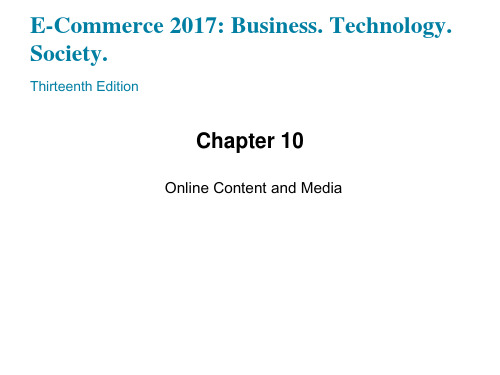
• Content convergence – Three aspects: Design, production, distribution – New tools for digital editing and processing
• Industry convergence – Merger of media enterprises into firms that create and cross-market content on different platforms
production business • Continued growth of online video and music • E-book sales growth slows • Digital music sales top physical sales • Console games flatten as mobile games soar
• Class Discussion – Do you subscribe to any online video streaming services? If so, which ones? – What sites have given you the best overall viewing or entertainment experience, and why? – What are the advantages of watching traditional television over watching online TV and films?
Trends in Online Content (1 of 2)
• Mobile platform accelerates the transition to digital content • Distributors become significant players in content
• Industry convergence – Merger of media enterprises into firms that create and cross-market content on different platforms
production business • Continued growth of online video and music • E-book sales growth slows • Digital music sales top physical sales • Console games flatten as mobile games soar
• Class Discussion – Do you subscribe to any online video streaming services? If so, which ones? – What sites have given you the best overall viewing or entertainment experience, and why? – What are the advantages of watching traditional television over watching online TV and films?
Trends in Online Content (1 of 2)
• Mobile platform accelerates the transition to digital content • Distributors become significant players in content
电子商务英文版最新课件ec13_ppt_ch05_accessible

Table 5.3 Customer and Merchant Perspectives on the Different Dimensions of E-Commerce Security (1 of 2)
Dimension Integrity
Customer’s Perspective
Has information I transmitted or received been altered?
– E-signatures – Multi-factor authentication – Fingerprint identification
• Three key points of vulnerability in e-commerce environment: – Client – Server – Communications pipeline (Internet communications channels)
Figure 5.2 A Typical E-Commerce Transaction
• Low-cost web attack kits • Online credit card fraud • Underground economy marketplace
What Is Good E-Commerce Security?
• To achieve highest degree of security – New technologies – Organizational policies and procedures – Industry standards and government laws
Availability
Customer’s Perspective Can someone other than the intended recipient read my messages?
电子商务课件英文版
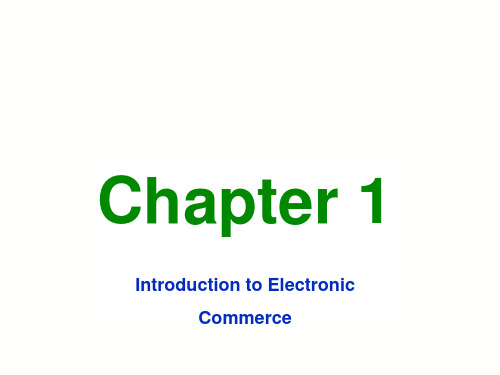
■ow economic forces have created a business environment s fostering the second wave of electronic commerce
(4) How businesses use value chains and SWOT analysis to identify electronic commerce opportunities
The Second Wave of Electronic Commerce
EC | Electronic Commerce:
〔The Second Wave (cont.)
1 Electronic commerce and Electronic business
♦ Electronic business (e-business)-broader sense
椅In the 2000 to 2003 period, many industry observers were writing obituaries(t卜告)for electronic commerce. Just as the unreasonable expectations for immediate success fueled the high expectations during the boom years, overly gloomy news reports colored perceptions during this time.
•Term used interchangeably with e-commerce
•The transformation of key business processes through the use of
(4) How businesses use value chains and SWOT analysis to identify electronic commerce opportunities
The Second Wave of Electronic Commerce
EC | Electronic Commerce:
〔The Second Wave (cont.)
1 Electronic commerce and Electronic business
♦ Electronic business (e-business)-broader sense
椅In the 2000 to 2003 period, many industry observers were writing obituaries(t卜告)for electronic commerce. Just as the unreasonable expectations for immediate success fueled the high expectations during the boom years, overly gloomy news reports colored perceptions during this time.
•Term used interchangeably with e-commerce
•The transformation of key business processes through the use of
电子商务 第13版 英文版教学课件8
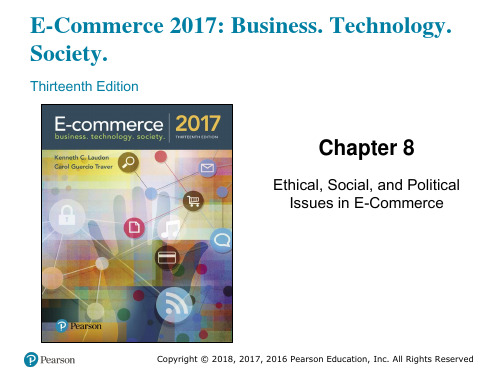
8.3 Understand the various forms of intellectual property and the challenges involved in protecting it.
8.4 Understand how the Internet is governed and why taxation of e-commerce raises governance and jurisdiction issues.
There must be a choice regime in place allowing consumers to choose how their information will be used for secondary purposes other than supporting the transaction, including internal use and transfer to third parties. Opt-in/opt-out must be available.
Copyright © 2018, 2017, 2016 Pearson Education, Inc. All Rights Reserved
Understanding Ethical, Social, and Political Issues iபைடு நூலகம் E-Commerce
• Internet, like other technologies, can: – Enable new crimes – Affect environment – Threaten social values
correctly
Copyright © 2018, 2017, 2016 Pearson Education, Inc. All Rights Reserved
8.4 Understand how the Internet is governed and why taxation of e-commerce raises governance and jurisdiction issues.
There must be a choice regime in place allowing consumers to choose how their information will be used for secondary purposes other than supporting the transaction, including internal use and transfer to third parties. Opt-in/opt-out must be available.
Copyright © 2018, 2017, 2016 Pearson Education, Inc. All Rights Reserved
Understanding Ethical, Social, and Political Issues iபைடு நூலகம் E-Commerce
• Internet, like other technologies, can: – Enable new crimes – Affect environment – Threaten social values
correctly
Copyright © 2018, 2017, 2016 Pearson Education, Inc. All Rights Reserved
电子商务英文版最新课件ec13_ppt_ch01_accessible

Assessing E-Commerce (1 of 2)
• Stunning technological success • Early years a mixed business success
– Few early dot-coms have survived – Online sales growing rapidly • Many early visions not fulfilled – Price dispersion – Information asymmetry – New intermediaries
Uber: The New Face of E-Commerce?
• Class Discussion – Have you used Uber or any other on-demand service companies? – What is the appeal of these companies for users and providers? – Are there any negative consequences to the increased use of on-demand services like Uber and Airbnb?
Assessing E-Commerce (2 of 2)
• Other surprises – Fast-follower advantages – Start-up costs – Impact of mobile platform – Emergence of on-demand e-commerce
1.2 Define e-commerce, understand how e-commerce differs from ebusiness, identify the primary technological building blocks underlying ecommerce, and recognize major current themes in e-commerce.
电子商务英语PPT演示文稿
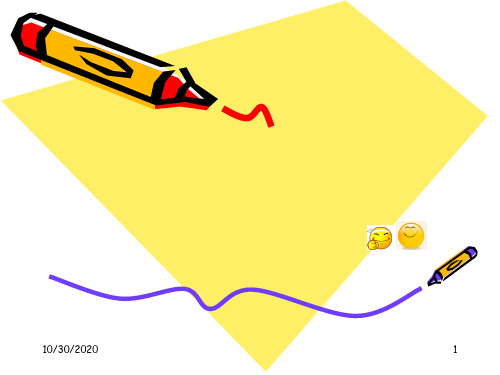
本演示文稿首先通过热身讨论引入电子商务英语的主题,探讨了电子商务公司提供的服务类型及其在电子商务中的角色。接着,介绍了电子商务的背景信息,强调物流过分析部分,深入探讨了电子商务时代物流面临的挑战,特别是在B2C和B2B领域。在B2C电子商务中,快速可靠的交付是赢得市场竞争优势的关键。而在B2B电子商务中,竞争焦点已从产品转向服务,实际上是供应链之间的竞争。此外,还指出了电子商务对物流服务的高要求,包括响应性和灵活性。响应性要求物流系统能够更好地满足客户的即时配送需求,而灵活性则是应对传统物流优化设施固定性的挑战。通过这些内容,本演示文稿全面介绍了电子商务英语的相关知识,帮助读者更好地理解和应对电子商务领域的实际问题和挑战。
电子商务英文版最新课件ec13_ppt_ch07_accessible
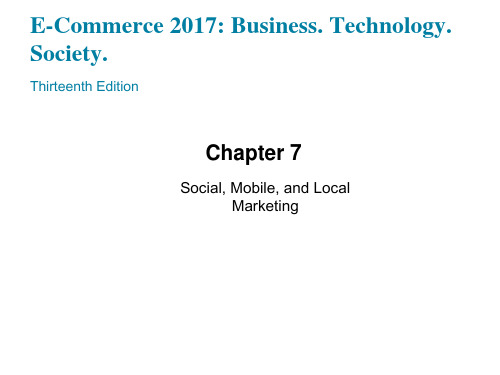
Introduction to Social, Mobile, and Local Marketing
• New marketing concepts – Conversations – Engagement
• Impact of smartphones and tablets • Social-mobile-local nexus
Social Marketing Players
• The most popular sites account for over 90% of all social network visits – Facebook, Google+, Twitter, LinkedIn, Pinterest, Instagram, Tumblr – Unique visitors vs. engagement ▪ Engagement measures the amount and intensity of user involvement ▪ Facebook dominates in both measures – Dark social – sharing outside of major social networks (e-mail, IM, texts, etc.)
Typical Twitter Marketing Campaign
• Follow others relevant to your content and conversation • Experiment with simple Promoted Tweets • For larger budgets, use Promoted Trends and TV ad
• Facebook analytics tools – Facebook Page Insights – Social media management systems (HootSuite) – Analytics providers (Google Analytics, Webtrends)
电子商务(全套英文版662页PPT课件)
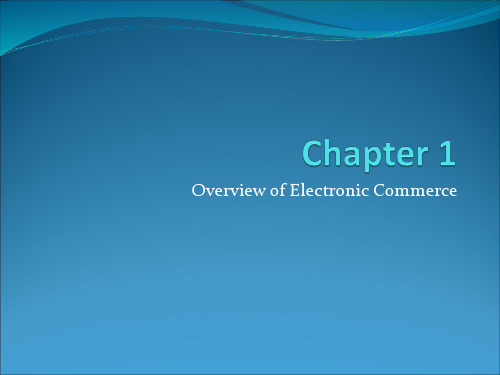
virtual (pure-play) organizations Organizations that conduct their business activities solely online
click-and-mortar (click-and-brick) organizations Organizations that conduct some e-commerce activities, usually as an additional marketing channel
consumers, and society. 10. List and describe the major limitations of EC.
2020/12/16
1-3
Electronic Commerce: Definitions and Concepts
electronic commerce (EC)
2020/12/16
1-4
Electronic Commerce: Definitions and Concepts
MAJOR EC CONCEPTS
Pure Versus Partial EC EC Organizations
brick-and-mortar (old economy) organizations Old-economy organizations (corporations) that perform their primary business offline, selling physical product
intranet An internal corporate or government network that uses Internet tools, such as Web browsers, and Internet protocols
click-and-mortar (click-and-brick) organizations Organizations that conduct some e-commerce activities, usually as an additional marketing channel
consumers, and society. 10. List and describe the major limitations of EC.
2020/12/16
1-3
Electronic Commerce: Definitions and Concepts
electronic commerce (EC)
2020/12/16
1-4
Electronic Commerce: Definitions and Concepts
MAJOR EC CONCEPTS
Pure Versus Partial EC EC Organizations
brick-and-mortar (old economy) organizations Old-economy organizations (corporations) that perform their primary business offline, selling physical product
intranet An internal corporate or government network that uses Internet tools, such as Web browsers, and Internet protocols
电子商务英文版最新课件ec13_ppt_ch09_accessible
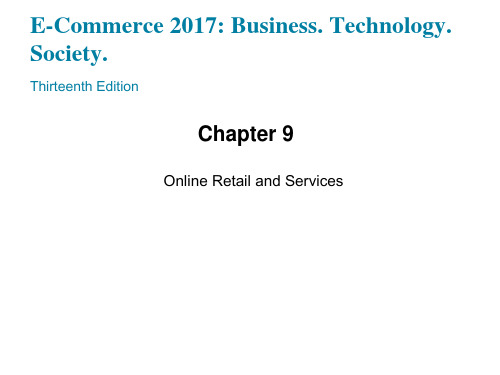
• Vision: – Earth's biggest selection, lowest prices, most customercentric
• Business model: – Retail, Third-Party Merchants, and Amazon Web Services
• Financial analysis: – Continued explosive revenue growth, profitable
ห้องสมุดไป่ตู้
What’s New in Online Retail
• Retail mobile e-commerce exploding • Social networks experiment with social e-commerce • Local e-commerce skyrockets to over $40 billion • Online retail still the fastest growing retail channel • Selection of goods increases, includes luxury goods • Specialty retail sites show rapid growth • New subscription-based model for online retailing • Big data used for predictive marketing
The Retail Industry
• 7 segments (clothing, durable goods, etc.) – For each, uses of Internet may differ ▪ Information vs. direct purchasing
• Business model: – Retail, Third-Party Merchants, and Amazon Web Services
• Financial analysis: – Continued explosive revenue growth, profitable
ห้องสมุดไป่ตู้
What’s New in Online Retail
• Retail mobile e-commerce exploding • Social networks experiment with social e-commerce • Local e-commerce skyrockets to over $40 billion • Online retail still the fastest growing retail channel • Selection of goods increases, includes luxury goods • Specialty retail sites show rapid growth • New subscription-based model for online retailing • Big data used for predictive marketing
The Retail Industry
• 7 segments (clothing, durable goods, etc.) – For each, uses of Internet may differ ▪ Information vs. direct purchasing
电子商务英文版最新课件ec13_ppt_ch02_accessible
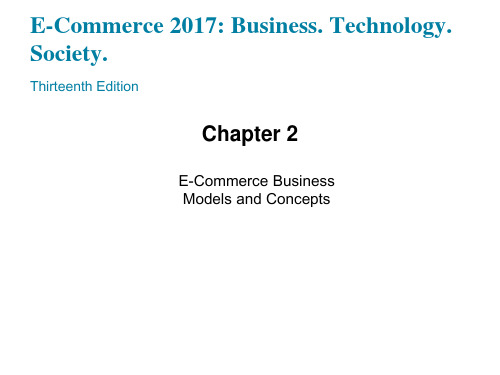
• Market opportunity typically divided into smaller niches
4. Competitive Environment
• “Who else occupies your intended marketspace?” – Other companies selling similar products in the same marketspace – Includes both direct and indirect competitors
E-Commerce Business Models
• Business model – Set of planned activities designed to result in a profit in a marketplace
• Business plan – Describes a firm’s business model
• E-commerce business model – Uses/leverages unique qualities of Internet and Web
Eight Key Elements of a Business Model
1. Value proposition 2. Revenue model 3. Market opportunity 4. Competitive environment 5. Competitive advantage 6. Market strategy 7. Organizational development 8. Management team
B2C Business Models
• E-tailer • Community provider (social network) • Content provider • Portal • Transaction broker • Market creator • Service provider
4. Competitive Environment
• “Who else occupies your intended marketspace?” – Other companies selling similar products in the same marketspace – Includes both direct and indirect competitors
E-Commerce Business Models
• Business model – Set of planned activities designed to result in a profit in a marketplace
• Business plan – Describes a firm’s business model
• E-commerce business model – Uses/leverages unique qualities of Internet and Web
Eight Key Elements of a Business Model
1. Value proposition 2. Revenue model 3. Market opportunity 4. Competitive environment 5. Competitive advantage 6. Market strategy 7. Organizational development 8. Management team
B2C Business Models
• E-tailer • Community provider (social network) • Content provider • Portal • Transaction broker • Market creator • Service provider
- 1、下载文档前请自行甄别文档内容的完整性,平台不提供额外的编辑、内容补充、找答案等附加服务。
- 2、"仅部分预览"的文档,不可在线预览部分如存在完整性等问题,可反馈申请退款(可完整预览的文档不适用该条件!)。
- 3、如文档侵犯您的权益,请联系客服反馈,我们会尽快为您处理(人工客服工作时间:9:00-18:30)。
• Online research influenced over $1.3 trillion of retail purchases in 2016
• Online traffic also influenced by offline brands and shopping
• E-commerce and traditional commerce are coupled: Part of a continuum of consuming behavior
• About 9% of Internet users don’t shop online – Trust factor – Hassle factors (shipping costs, returns, etc.)
Trust, Utility, and Opportunism in Online Markets
Consumers Online: The Internet Audience and Consumer Behavior (1 of 3)
• Over 75% (92 million) of U.S. households had broadband Internet access in 2016
• Two most important factors shaping decision to purchase online: – Utility: ▪ Better prices, convenience, speed – Trust: ▪ Perception of credibility, ease of use, perceived risk ▪ Sellers develop trust by building strong reputations for honesty, fairness, delivery
– User characteristics – Product characteristics – Website features: latency, usability, security – Attitudes toward online purchasing – Perceptions about control over online environment • Clickstream behavior
What Consumers Shop for and Buy Online
• Big ticket items ($1000 or more) – Travel, computer hardware, electronics – Consumers now more confident in purchasing costlier items
– Social networks, blogs, video, games • Mobile marketing
– Mobile/tablet sites, apps • Offline marketing
– Television, radio, newspapers
Insight on Business: Are the Very Rich Different from You and Me?
• Community effects – Role of social emulation in consumption decisions – “Connectedness” ▪ Top 10–15% are more independent ▪ Middle 50% share more purchase patterns of friends – Recommender systems – co-purchase networks
How Consumers Shop
• How shoppers find online vendors – Highly intentional, goal-oriented – Search engines – Marketplaces (Amazon, eBay) – Specific retail site
• The most effective Internet marketing has all four features
Multi-Channel Marketபைடு நூலகம்ng Plan
• Website • Traditional online marketing
– Search engine, display, e-mail, affiliate • Social marketing
E-Commerce 2017: Business. Technology. Society.
Thirteenth Edition
Chapter 6
E-Commerce Marketing and Advertising Concepts
Learning Objectives
6.1 Understand the key features of the Internet audience, the basic concepts of consumer behavior and purchasing, and how consumers behave online.
Figure 6.2 The Consumer Decision Process and Supporting Communications
The Online Purchasing Decision (2 of 2)
• Decision process similar for online and offline behavior • General online behavior model
• Class Discussion – What distinguishes luxury marketing from ordinary retail marketing? – What challenges do luxury retailers have in translating their brands and the look and feel of luxury shops into websites? – How has social media affected luxury marketing? – Visit the Armani website. What do you find there?
• Growth rate has slowed • Intensity and scope of use both increasing • Some demographic groups have much higher
percentages of online usage – Income, education, age, ethnic dimensions
6.4 Understand the costs and benefits of online marketing communications.
Video Ads: Shoot, Click, Buy
• Class Discussion – What advantages do video ads have over traditional banner ads? – Where do sites such as YouTube fit in to a marketing strategy featuring video ads? – What are some of the challenges and risks of placing video ads online? – Do you think Internet users will ever develop “blindness” toward video ads as they have towards display ads?
Digital Commerce Marketing and Advertising: Strategies and Tools
• Features of Internet marketing (vs. traditional) – More personalized – More participatory – More peer-to-peer – More communal
• Five stages in consumer decision process – Awareness of need – Search for more information – Evaluation of alternatives – Actual purchase decision – Post-purchase contact with firm
6.2 Identify and describe the basic digital commerce marketing and advertising strategies and tools.
6.3 Identify and describe the main technologies that support online marketing.
Figure 6.3 A Model of Online Consumer Behavior
Shoppers: Browsers and Buyers
• Shoppers: Almost 90% of Internet users – Over 77% buyers – 13.8% browsers (purchase offline)
Consumers Online: The Internet Audience and Consumer Behavior (3 of 3)
• Consumer behavior models – Study of consumer behavior; social science discipline – Attempt to predict or explain wide range of consumer decisions – Based on background demographic factors and other intervening, more immediate variables
• Online traffic also influenced by offline brands and shopping
• E-commerce and traditional commerce are coupled: Part of a continuum of consuming behavior
• About 9% of Internet users don’t shop online – Trust factor – Hassle factors (shipping costs, returns, etc.)
Trust, Utility, and Opportunism in Online Markets
Consumers Online: The Internet Audience and Consumer Behavior (1 of 3)
• Over 75% (92 million) of U.S. households had broadband Internet access in 2016
• Two most important factors shaping decision to purchase online: – Utility: ▪ Better prices, convenience, speed – Trust: ▪ Perception of credibility, ease of use, perceived risk ▪ Sellers develop trust by building strong reputations for honesty, fairness, delivery
– User characteristics – Product characteristics – Website features: latency, usability, security – Attitudes toward online purchasing – Perceptions about control over online environment • Clickstream behavior
What Consumers Shop for and Buy Online
• Big ticket items ($1000 or more) – Travel, computer hardware, electronics – Consumers now more confident in purchasing costlier items
– Social networks, blogs, video, games • Mobile marketing
– Mobile/tablet sites, apps • Offline marketing
– Television, radio, newspapers
Insight on Business: Are the Very Rich Different from You and Me?
• Community effects – Role of social emulation in consumption decisions – “Connectedness” ▪ Top 10–15% are more independent ▪ Middle 50% share more purchase patterns of friends – Recommender systems – co-purchase networks
How Consumers Shop
• How shoppers find online vendors – Highly intentional, goal-oriented – Search engines – Marketplaces (Amazon, eBay) – Specific retail site
• The most effective Internet marketing has all four features
Multi-Channel Marketபைடு நூலகம்ng Plan
• Website • Traditional online marketing
– Search engine, display, e-mail, affiliate • Social marketing
E-Commerce 2017: Business. Technology. Society.
Thirteenth Edition
Chapter 6
E-Commerce Marketing and Advertising Concepts
Learning Objectives
6.1 Understand the key features of the Internet audience, the basic concepts of consumer behavior and purchasing, and how consumers behave online.
Figure 6.2 The Consumer Decision Process and Supporting Communications
The Online Purchasing Decision (2 of 2)
• Decision process similar for online and offline behavior • General online behavior model
• Class Discussion – What distinguishes luxury marketing from ordinary retail marketing? – What challenges do luxury retailers have in translating their brands and the look and feel of luxury shops into websites? – How has social media affected luxury marketing? – Visit the Armani website. What do you find there?
• Growth rate has slowed • Intensity and scope of use both increasing • Some demographic groups have much higher
percentages of online usage – Income, education, age, ethnic dimensions
6.4 Understand the costs and benefits of online marketing communications.
Video Ads: Shoot, Click, Buy
• Class Discussion – What advantages do video ads have over traditional banner ads? – Where do sites such as YouTube fit in to a marketing strategy featuring video ads? – What are some of the challenges and risks of placing video ads online? – Do you think Internet users will ever develop “blindness” toward video ads as they have towards display ads?
Digital Commerce Marketing and Advertising: Strategies and Tools
• Features of Internet marketing (vs. traditional) – More personalized – More participatory – More peer-to-peer – More communal
• Five stages in consumer decision process – Awareness of need – Search for more information – Evaluation of alternatives – Actual purchase decision – Post-purchase contact with firm
6.2 Identify and describe the basic digital commerce marketing and advertising strategies and tools.
6.3 Identify and describe the main technologies that support online marketing.
Figure 6.3 A Model of Online Consumer Behavior
Shoppers: Browsers and Buyers
• Shoppers: Almost 90% of Internet users – Over 77% buyers – 13.8% browsers (purchase offline)
Consumers Online: The Internet Audience and Consumer Behavior (3 of 3)
• Consumer behavior models – Study of consumer behavior; social science discipline – Attempt to predict or explain wide range of consumer decisions – Based on background demographic factors and other intervening, more immediate variables
